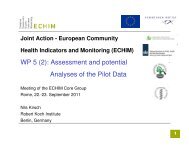INDICATORS
ECHIM Final Report
ECHIM Final Report
Create successful ePaper yourself
Turn your PDF publications into a flip-book with our unique Google optimized e-Paper software.
Calculation: Eurostat:<br />
a) Average length of stay for all hospitals is computed by dividing the total number of<br />
hospital days (or bed-days or in-patient days) in all hospitals from the date of admission in<br />
an in-patient institution (date of discharge minus date of admission) by the total number<br />
of discharges (including deaths) in all hospitals during the given year. Calculated by the<br />
categories of the International Shortlist for Hospital Morbidity Tabulation (ISHMT).<br />
Hospital days and and discharges for inpatients with principal diagnoses not falling into the<br />
ISHMT group of diagnoses are excluded. Same day cases are also exluded. ALOS should<br />
preferably be provided to the accuracy of hundreds, i.e. 0.01.<br />
b) Average length of stay for acute care hospitals is computed by dividing the total number<br />
of hospital days (or bed-days or in-patient days) in acute care hospitals from the date of<br />
admission in an in-patient institution (date of discharge minus date of admission) by the<br />
total number of discharges (including deaths) in acute care hospitals during the given year.<br />
Calculated by the categories of the International Shortlist for Hospital Morbidity Tabulation<br />
(ISHMT). Hospital daysand and discharges for inpatients with principal diagnoses not<br />
falling into the ISHMT group of diagnoses are excluded. Same day cases are also exluded.<br />
ALOS should preferably be provided to the accuracy of hundreds, i.e. 0.01.<br />
Notes: Eurostat and OECD, both institutions, are collecting the data from national sources<br />
with a common questionnaire (CARE, non-expenditure, which includes a common MDS<br />
on hospitals).<br />
OECD: average length of stay (ALOS) is calculated by dividing the number of days stayed<br />
(from the date of admission in an in-patient institution) by the number of discharges<br />
(including deaths).<br />
WHO: average length of stay is calculated as total number of occupied hospital bed-days<br />
divided by the total number of admissions or discharges. Length of stay (LOS) of one patient<br />
= date of discharge – date of admission. If these are the same dates, then LOS is set to one<br />
day. ALOS should preferably be provided to the accuracy of hundreds, i.e. 0.01.<br />
71. GENERAL PRACTITIONER (GP) UTILISATION<br />
Definition: Mean number of visits to general practitioner per capita per year. General<br />
practitioner (GP) is a physician (medical doctor) who does not limit his/her practice to<br />
certain disease categories and assumes the responsibility for the provision of continuing and<br />
comprehensive medical care or referring to another health care professional. However, in<br />
some countries, GP is treated as a specialisation..<br />
Calculation:<br />
1) Average number of contacts with a general practitioner (self-reports) per capita per year,<br />
derived from EHIS questions on GP visits, HC.11: During the past four weeks ending<br />
yesterday, that is since (date), how many times did you consult a GP (general practitioner) or<br />
family doctor on your own behalf? (0, 1, 2 etc).<br />
2) Eurostat: the average number of patient contacts to GP (self reports from survey: the<br />
Eurostat European Community Household Panel, ECHP) within a calendar year.<br />
Notes: EHIS recall period of 4 weeks is not optimal for calculating number of visits per year.<br />
The introduction to EHIS questions (HC.10 and) HC.11 is: “The next set of questions is<br />
about consultations with your general practitioner or family doctor. Please include visits to<br />
your doctor’s practice as well as home visits and consultations by telephone.”<br />
126










